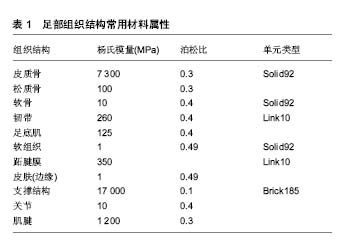| [1] 温建民,孙卫东,成永忠,等. 基于CT图像拇外翻足有限元模型的建立与临床意义[J]. 中国矫形外科杂志, 2012,20(11): 1026-1029.[2] Behforootan S, Chatzistergos P, Naemi R, et al. Finite element modeling of the foot for clinical application: A systematic review. Med Eng Phys. 2017;39:1-11.[3] Trabelsi N, Milgrom C, Yosibash Z. Patient-specific FE analyses of metatarsal bones with inhomogeneous isotropic material properties. J Mech Behav Biomed Mater. 2014;29: 177-189.[4] Cheung JT, Zhang M. A 3-dimensional finite element model of the human foot and ankle for insole design. Arch Phys Med Rehabil. 2005;86(2):353-358.[5] Lemmon D, Cavanagh P. Finite element modeling of plantar pressure beneath the second ray with flexor muscle loading. Clin Biomech(Bristol, Avon). 1997;12(3):S13-S14.[6] Gefen A. Stress analysis of the standing foot following surgical plantar fascia release. J Biomech. 2002;35(5):629-637.[7] Patil KM, Jacob S. Mechanics of tarsal disintegration and plantar ulcers in leprosy by stress analysis in three dimensional foot models. Indian J Lepr. 2000;72(1):69-86.[8] Nakamura S, Crowninshield RD, Cooper RR. An analysis of soft tissue loading in the foot--a preliminary report. Bull Prosthet Res. 1981;10-35:27-34.[9] Buchler P, Ramaniraka NA, Rakotomanana LR, et al.A finite element model of the shoulder: application to the comparison of normal and osteoarthritic joints. Clin Biomech(Bristol, Avon). 2002;17(9-10):630-639.[10] Race A, Amis AA. The mechanical properties of the two bundles of the human posterior cruciate ligament. J Biomech. 1994;27(1):13-24.[11] Wright DG, Rennels DC. A study of the elastic properties of plantar fascia. J Bone Joint Surg Am. 1964;46:482-492.[12] Isvilanonda V, Dengler E, Iaquinto JM, et al. Finite element analysis of the foot: model validation and comparison between two common treatments of the clawed hallux deformity. Clin Biomech (Bristol, Avon). 2012;27(8):837-844.[13] 陶凯,王冬梅,王成焘,等. 韧带和跖腱膜在足部有限元分析中的力学作用[J]. 生物医学工程学杂志, 2008,25(2):336-340.[14] 金立夫,胡海威,温建民,等. 第1跖楔关节失稳与母外翻术后转移性跖骨痛相关性-前足跖骨头下压力的有限元研究[J]. 中国矫形外科杂志, 2013,21(9):908-913.[15] 王旭,马昕,陶凯,等.足踝有限元模型的建立与初步临床应用[J]. 中国生物医学工程学报, 2008,27(2):287-292.[16] 王旭,陶凯,马昕,等. 第一跖列负重变化对母趾形态影响的有限元分析[J]. 复旦学报(医学版),2006,33(2):167-170.[17] 刘清华,余斌,金丹,等. 解剖结构完整的踝关节有限元模型构建及意义[J]. 山东医药,2010,50(14):1-3.[18] 陶凯,王冬梅,王成焘,等. 基于三维有限元静态分析的人体足部生物力学研究[J]. 中国生物医学工程学报, 2007,26(5): 763-766+80.[19] 牛文鑫,杨云峰,俞光荣,等. 人体足部三维有限元模型的有效构建方法及其合理性的实验分析研究[J]. 生物医学工程学杂志, 2009,26(1):80-84.[20] 金乾坤,何盛为,何飞熊,等. 足踝部三维有限元仿真模型的构建及验证[J]. 中国数字医学,2016,11(4):83-86.[21] Morales-Orcajo E, Bayod J, Becerro-de-Bengoa-Vallejo R, et al.Influence of first proximal phalanx geometry on hallux valgus deformity: a finite element analysis. Med Biol Eng Comput. 2015;53(7):645-653.[22] Wong DW, Zhang M, Yu J, et al. Biomechanics of first ray hypermobility: an investigation on joint force during walking using finite element analysis. Med Eng Phys. 2014;36(11): 1388-1393.[23] Kai T, Cheng-Tao W, Dong-Mei W, et al. Primary analysis of the first ray using a 3-dimension finite element foot model. Conf Proc IEEE Eng Med Biol Soc. 2005;3:2946-2949.[24] 孙卫东,温建民,胡海威,等. 拇外翻第1跖骨颈部不同截骨角度截骨端稳定性有限元分析[J]. 中华损伤与修复杂志(电子版), 2012, 7(5):492-496.[25] 孙卫东,胡海威,温建民,等. 第1跖骨颈部微创截骨联合分趾垫和“8”字绷带外固定治疗拇外翻的有限元分析[J].中医正骨,2014, 26(4):3-6.[26] 毕春强,温建民,孙卫东,等. 静态有限元法分析基于“裹帘”法外固定拇外翻术后截骨端的稳定性[J]. 中国组织工程研究, 2016, 20(22):3294-3300.[27] Matzaroglou C, Bougas P, Panagiotopoulos E, et al. Ninety-degree chevron osteotomy for correction of hallux valgus deformity: clinical data and finite element analysis. The open orthopaedics journal. 2010;4:152-6.[28] Wong D, Wang Y, Zhang M, et al. Functional restoration and risk of non-union of the first metatarsocuneiform arthrodesis for hallux valgus: A finite element approach. Journal Biomech. 2015;48(12):3142-3148.[29] Kristen KH, Berger K, Berger C, et al. The first metatarsal bone under loading conditions: a finite element analysis. Foot Ankle Clin. 2005;10(1):1-14.[30] 边蔷,胡海威,温建民,等. 足部相关肌肉、肌腱组织材料弹性模量的测定[J]. 中国组织工程研究,2015,19(12):1919-1923.[31] Wang Y, Wong DW, Zhang M. Computational models of the foot and ankle for pathomechanics and clinical applications: a review. Ann Biomed Eng. 2016;44(1):213-221.[32] Perrier A, Luboz V, Bucki M, et al. Conception and evaluation of a 3D musculoskeletal finite element foot model. Comput Methods Biomech Biomed Engin. 2015;18 Suppl 1: 2024-2025.[33] 周宇宁,张宏,陈相春,等. 建立足部三维有限元数字模型[J]. 中国组织工程研究,2015,19(5):662-666. |
.jpg)



.jpg)
.jpg)